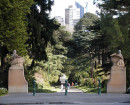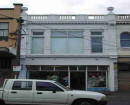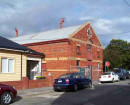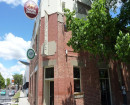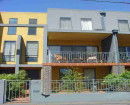HEYWOOD TOWNSHIP PRECINCT
EDGAR STREET, and HUNTER STREET, and SCOTT STREET, HEYWOOD, GLENELG SHIRE
-
Add to tour
You must log in to do that.
-
Share
-
Shortlist place
You must log in to do that.
- Download report


Statement of Significance
Heywood is a small town, located on the Princes Highway where it crosses the Fitzroy River about 25kms due north of Portland and the coast. It is arguably one of the oldest inland settlements in Victoria beginning, as was usual, with a public house located at a ford which was soon superseded by a bridge built by the first publican. The crossing was critical for access to the vast pastoral holdings to the north-west and to the north-east. There was an extra impetus to its foundation from the nearby Mounted Police Barracks and Native Police Barracks. Although small, the town survives as a service centre for the immediate district and as a junction of the Princes and Henty Highways. Heywood experienced boom in the post war years as a result of the increase in the price of wool. As a result, many of the commercial buildings in Edgar Street were modernised with new facades, or demolished for new buildings to be erected. Edgar Street has long been the main thoroughfare of the township, and follows the original route from Portland to Dartmoor and eventually Adelaide in one direction and to Hamilton in the other. Most of the buildings in the centre of the town are commercial and civic and all but one are single-storey. The wide main street is laid out as a grand boulevard with median plantings. It is dominated on the east side by the former Gothic revival Heywood State School and on the west by the two-storey Heywood Hotel. An obelisk on the eastern median strip on axis with the school commemorates those who served and fell in World War One and Two. The settlement started officially in 1841, when a licence was granted to the Bush Inn which was established by David Edgar, an important squatter as well as a publican. The town has been primarily a service centre for the surrounding pastoral properties, and later as a timber town. The contributory heritage places are mainly clustered between Cameron Street and Scott Street. Although much has been lost over the years, the precinct retains a fair degree of integrity and is in good condition.
How is it significant?
The HeywoodTownship Precinct is of historical, social and architectural significance to the Glenelg Shire.
Why is it significant?
The HeywoodTownship Precinct is of historic significance as a township dating from the late 1830s, as one of the chain of small settlements between Portland, Hamilton and Penola and as the focus for the pastoral properties surrounding the township from the early 1840s onward. It is of social significance as the focus for the community's education and recreation, roles that continue to the present. The architectural significance of the town lies in the limited number of buildings constructed from local materials over a long period of time, particularly the former Heywood State School and the Heywood Hotel. Of further significance is the collection of post World War Two buildings in the commercial centre, which represent the prosperity in the township and surrounding district in the 1950s and 60s as a result of the woolboom.
-
-
HEYWOOD TOWNSHIP PRECINCT - Physical Description 1
The Heywood Commercial precinct is located along the Princes Highway (Edgar Street), from the Fitzroy River through to Railway Drive and Markham Street. The precinct covers most of the commercial shopping strip, the State School No. 297, the railway station, the Heywood Community Centre, some other civic buildings and structures, the street trees and the one surviving hotel. The various churches lie outside the precinct, as they are generally set back from the main thoroughfare, Edgar Street. The surviving commercial premises date from as early as the 1860s, although there is a fair representation of buildings through to the 1960s. A number of contributory nineteenth and early twentieth century buildings are clustered on the east side of Edgar Street, particularly between Scott Street and Railway Drive. These are mainly single storey timber dwellings.
The buildings in the northern part of Edgar Street are primarily commercial or civic. Along the west side of Edgar Street there is a range of single storey commercial premises. Many of these are mid to late nineteenth century shops which have had post World War Two facades built on during the wool boom years in the middle of the twentieth century. The two-storey Heywood Hotel, located at the north-west corner of Edgar and Scott Street dominates and acts as a keystone for the precinct. It is the tallest and the longest building in the streetscape. Along the east side of Edgar Street there are some single-storey commercial buildings, mainly on a larger scale, including a number of structures which relate to the car industry. This side of the street is dominated by the former Heywood State School which is set in extensive grounds, the openness of which is an important part of the precinct's character. The school is much extended but the loosely Gothic revival style is consistently applied and the main building retains a high degree of integrity. The small octagonal shelter shed is also important. The boulevard planting in the median strips of Edgar Street is important and this is reinforced by the prominence and axial planning of the grey granite obelisk which is the war memorial. All of the buildings in the Heywood precinct, except the State School, are built up to the street boundary. The construction materials are local stone, brick or timber, with some buildings having later modifications of other materials. At the southern edge of the precinct is the moderne Civic Hall (now the Community Centre) which is a large two storey structure in cream brick, set in an open space, which again is part of its significance. The former Railway Station building is located on the boundary of the precinct on the northeast corner of Railway Drive, and is the only surviving building on the Railway land which represents this once thriving Railway Complex.
In the 1990s and early 2000s, a program of beautification of the main commercial area of Edgar Street commenced. New paving and traffic islands were incorporated into the street design, as were new seats, appropriate plantings and other elements. These are not contributory elements. The much older Eucalypt which survives outside the Heywood Hotel is important for its contribution to the significance of the precinct.
Geographically, this area is on the river flat, and has been prone to flooding in the past. Nonetheless, the integrity of most of the surviving buildings within the precinct is very high and their condition is good. Overall, the precinct retains a fair degree of integrity and is generally in good condition.CONTRIBUTORY PLACES.
Timber House, 22 Edgar Street, Heywood
. Timber House, 30 Edgar Street, Heywood
. Shop 51 Edgar Street, Heywood
. Post office, 52 Edgar Street, Heywood
. Store, 55 Edgar Street, Heywood
. Butcher Shop, 57 Edgar Street, Heywood
. Shop, 65 Edgar Street, Heywood
. Store, 66 Edgar Street, Heywood
. Shop, 75 Edgar Street, Heywood
. Edwardian House, 81 Edgar Street, Heywood
Riverlea, 4 Hunter Street, Heywood
SIGNIFICANT PLACES
. Heywood Hotel, 47 Edgar Street
. State School No. 297 and War Memorial , 54-58 Edgar Street, Heywood
. Foodworks, 69-71 Edgar Street Heywood
. Glenelg Shire Council Offices, 77 Edgar Street, Heywood
. Street Trees, median strip, Edgar Street [between Scott Street and the Fitzroy River Road Bridge], Heywood
. Scout Hall, 9 Scott Street, Heywood
. Shire Hall, 20 Edgar Street, Heywood
Railway Station, 18 Edgar Street Heywood
Heritage Study and Grading
Glenelg - Glenelg Shire Heritage Study Part One
Author: Carlotta Kellaway, David Rhodes Mandy Jean
Year: 2002
Grading:Glenelg - Glenelg Heritage Study Stage Two (a)
Author: Heritage Matters
Year: 2006
Grading: Local
-
-
-
-
-
OLD HOSPITAL
 Southern Grampians Shire
Southern Grampians Shire -
ST. JOHN'S ANGLICAN CHURCH
 Glenelg Shire
Glenelg Shire -
ST. GREGORY'S CATHOLIC CHURCH
 Glenelg Shire
Glenelg Shire
-
-


